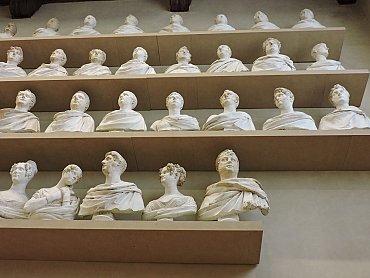Bartolini Plaster Cast Gallery at the Accademia Gallery

The Accademia Gallery in Florence was founded in 1784 by the Grand Duke Peter Leopold of Lorraine, who converted the former hospital of San Matteo in a place for studying and hosting artwork models for students.
In what once was the hospital wing used as a women's ward, now there is the Plaster Cast Gallery, which contains models created by Lorenzo Bartolini, artist and professor at the Academy, in an environment that ideally recreates the atmosphere of a sculpture studio of the XIX century, very similar to the study that Bartolini had in Borgo San Frediano.
Here we can find exposed various kinds of busts, full figures or monumental sepulchral works. Among the subjects there are models designed to celebrate Tuscan artists like Machiavelli (by Bartolini), Arnolfo di Cambio and Brunelleschi (by Pampaloni), and wealthy aristocrats who settled in Florence in XIX century. We find for example busts of personalities who frequented his studio, from Rossini to Liszt, from Lord Byron to Madame de Stael.
Many Russian, English and Polish noble families in fact entrusted to Lorenzo Bartolini and Luigi Pampaloni the realization of portraits, medallions and catafalques to commemorate their loved ones. Many great personalities who led the European political fortunes of the early XIX century, animated lounges, theaters, scientific circles, crowd now the plaster cast gallery narrating a century of great ideals, art, music and poetry in a worldly and cosmopolitan, cultured and refined Florence.
Bartolini was highly valued for his unique ability to delineate graceful faces provided with expressive personality thanks to a subtle work of psychological investigation. From the works we can deduce many things on the aesthetic taste of the period, with hairstyles and clothes inspired to the ancient classical world.
On display at the gallery there are over two hundred and fifty busts through which we can understand the long process of building the model. For example, we can still see the dark spots that characterize the surfaces of the models, they are nails or metal points that were used as references when slotting the block of marble .Or we can also learn something thanks to an interesting video that explains the ancient technique of forming.
At the left side of the gallery there is a fresco of small size painted by Jacopo Carrucci, known as Pontormo, around 1514.This is the first work painted by Pontormo and depicts a scene of hospital life, indicating the original use of the Gallery.











